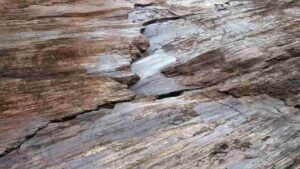
When an earthquake hits, it is rarely an isolated event. Foreshocks precede quakes, and aftershocks follow them. To quantify seismic hazards, scientists must disentangle the factors that contribute to these shaking sequences.
In recent years, advancements in laboratory methods have enabled deeper exploration of earthquake dynamics. Now, Goebel and colleagues present new lab findings highlighting how the roughness of the rocks sliding past each other in a fault zone may influence aftershocks.
The researchers created fractures of varying roughness in several granite cylinders ranging from 40 to 50 millimeters in diameter. Then they applied pressure to the fractured granite to simulate sliding motions along a fault. They measured the resulting seismic disturbances in high resolution in the form of acoustic emission wave measurements.
The result was a realistic and manipulable simulation of actual earthquakes: Spacing and timing of the main slips, foreshocks, and aftershocks in the granite cylinders resembled those of real-world Southern California earthquakes.
The researchers found that after a major slip along a fracture—analogous to a main earthquake along a fault—the granite cylinders underwent periods of relaxation of built-up stress as well as aftershocks. Fractures with greater roughness moved less along the fracture during the main slip event but had more aftershocks; smoother fractures had more slip but fewer aftershocks.
These findings suggest that in nature, fault surface roughness may play a key role in the production of aftershocks following a main earthquake event.
The research is published in the journal Geophysical Research Letters.
Reference:
Thomas H. W. Goebel et al, Fault Roughness Promotes Earthquake‐Like Aftershock Clustering in the Lab, Geophysical Research Letters (2023). DOI: 10.1029/2022GL101241
Note: The above post is reprinted from materials provided by American Geophysical Union.










